Urban area
An urban area, built-up area or urban agglomeration is a human settlement with a high population density and an infrastructure of built environment. This is the core of a metropolitan statistical area in the United States, if it contains a population of more than 50,000.[1]



Urban areas originate through urbanization, and researchers categorize them as cities, towns, conurbations or suburbs. In urbanism, the term "urban area" contrasts to rural areas such as villages and hamlets; in urban sociology or urban anthropology it contrasts with natural environment.
The development of earlier predecessors of modern urban areas during the urban revolution of the 4th millennium BCE[2] led to the formation of human civilization and ultimately to modern urban planning, which along with other human activities such as exploitation of natural resources has led to a human impact on the environment.
Historical growth
In 1950, around the world, 764 million people lived in urban areas. By 2014, it was 3.9 billion. The change was driven by a combination of increased total population and increased percent of population living in urban areas.[3] In 2009, the number of people living in urban areas (3.42 billion) surpassed the number living in rural areas (3.41 billion), and since then the world has become more urban than rural.[4] This was the first time that the majority of the world's population lived in a city.[5] In 2014 there were 7.3 billion people living on the planet,[6] of which the global urban population comprised 3.9 billion. The Population Division of the United Nations Department of Economic and Social Affairs at that time predicted the urban population would occupy 68% of the world population by 2050, with 90% of that growth coming from Africa and Asia.[7] By 2022, there are now about 8 Billion living on the planet Earth.
Urbanization
%252C_OWID.svg.png.webp)

Urban areas are created and further developed by the process of urbanization. They are measured for various purposes, including analyzing population density and urban sprawl. Urban areas are also mostly found in the United States, Canada, Brazil, Mexico, Argentina, Chile, Japan and Australia and many other countries where the urbanization rate is over 80%.
Unlike an urban area, a metropolitan area includes not only the urban area, but also satellite cities plus intervening rural land that is socio-economically connected to the urban core city, typically by employment ties through commuting, with the urban core city being the primary labor market.
The concept of an "urban area" as used in economic statistics should not be confused with the concept of the "urban area" used in road safety statistics. This term was first created by Geographer Brian Manning. The last concept is also known as "built-up area in road safety". According to the definition by the Office for National Statistics, "Built-up areas are defined as land which is 'irreversibly urban in character', meaning that they are characteristic of a town or city. They include areas of built-up land with a minimum of 20 hectares (200,000 m2; 49 acres). Any areas [separated by] less than 200 metres [of non-urban space] are linked to become a single built-up area.[9]
Argentina and Japan are countries where the urbanization rate is over 90% while Australia, Brazil, Canada, Chile, Mexico and the United States are countries where the urbanization rate is between 80% and 90%.
Largest urban areas
There are two measures of the degree of urbanization of a population. The first, urban population, describes the percentage of the total population living in urban areas, as defined by the country. The second measure, rate of urbanization, describes the projected average rate of change of the size of the urban population over the given period of time. According to Urbanization by sovereign state article, the world as a whole is 56.2% urbanized, with roughly one-quarter of the countries reported as greater than 80% urbanized. Data is taken from the U.S. Central Intelligence Agency World Factbook estimates from 2020.[10]
Largest urban areas in the world
According to The World Factbook:[11]
Very highly urbanized countries
This is the a partial list of countries where the urbanization rate is at least 80%:
 Argentina
Argentina.svg.png.webp) Australia
Australia Brazil
Brazil.svg.png.webp) Canada
Canada Chile
Chile France
France Israel
Israel Japan
Japan South Korea
South Korea Mexico
Mexico Spain
Spain United Kingdom
United Kingdom United States
United States
Those with the rate at 100%:
- Kuwait
- Monaco, a European city state, principality located in France (a semi-enclave within the French Riviera)
- Nauru, an island country
- Singapore, an island country and city state
- Vatican City, a city state, and the smallest country, the papacy located within (enclave) Rome, Italy
Definitions
The UN publishes data on cities, urban areas and rural areas, but relies almost entirely on national definitions of these areas. The UN principles and recommendations state that due to different characteristics of urban and rural areas across the globe, a global definition is not possible.[12]
European countries define urbanized areas on the basis of urban-type land use, not allowing any gaps of typically more than 200 metres (220 yd), and use satellite imagery instead of census blocks to determine the boundaries of the urban area. In less-developed countries, in addition to land use and density requirements, a requirement that a large majority of the population, typically 75%, is not engaged in agriculture and/or fishing is sometimes used.
By region
China
Since 2000, China's cities have expanded at an average rate of 10% annually. It is estimated that China's urban population will increase by 292 million people by 2050,[3] when its cities will house a combined population of over one billion.[13] The country's urbanization rate increased from 17.4% to 46.6% between 1978 and 2009.[14] Between 150 and 200 million migrant workers work part-time in the major cities, returning home to the countryside periodically with their earnings.[15][16]
China has more cities with one million or more long-term residents than any other country, including the three global cities of Beijing, Hong Kong, and Shanghai; by 2025, the country will be home to 221 cities with over a million inhabitants.[13] The figures in the table below are from the 2008 census, and are only estimates of the urban populations within administrative city limits; a different ranking exists when considering the total municipal populations (which includes suburban and rural populations). The large "floating populations" of migrant workers make conducting censuses in urban areas difficult;[17] the figures below include only long-term residents.
| Rank | Name | Province | Pop. | Rank | Name | Province | Pop. | ||
|---|---|---|---|---|---|---|---|---|---|
 Shanghai .jpg.webp) Beijing |
1 | Shanghai | SH | 24,281,400 | 11 | Hong Kong | HK | 7,448,900 |  Guangzhou 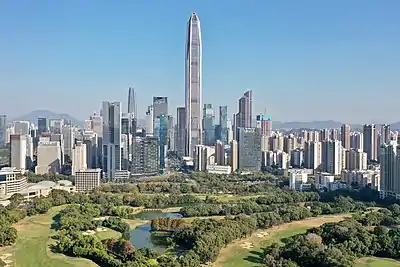 Shenzhen |
| 2 | Beijing | BJ | 19,164,000 | 12 | Zhengzhou | HA | 7,179,400 | ||
| 3 | Guangzhou | GD | 13,858,700 | 13 | Nanjing | JS | 6,823,500 | ||
| 4 | Shenzhen | GD | 13,438,800 | 14 | Xi'an | SN | 6,642,100 | ||
| 5 | Tianjin | TJ | 11,744,400 | 15 | Jinan | SD | 6,409,600 | ||
| 6 | Chongqing | CQ | 11,488,000 | 16 | Shenyang | LN | 5,900,000 | ||
| 7 | Dongguan | GD | 9,752,500 | 17 | Qingdao | SD | 5,501,400 | ||
| 8 | Chengdu | SC | 8,875,600 | 18 | Harbin | HL | 5,054,500 | ||
| 9 | Wuhan | HB | 8,652,900 | 19 | Hefei | AH | 4,750,100 | ||
| 10 | Hangzhou | ZJ | 8,109,000 | 20 | Changchun | JL | 4,730,900 | ||
- Population of Hong Kong as of 2018 estimate.[19]
- The data of Chongqing in the list is the data of "Metropolitan Developed Economic Area", which contains two parts: "City Proper" and "Metropolitan Area". The "City proper" are consist of 9 districts: Yuzhong, Dadukou, Jiangbei, Shapingba, Jiulongpo, Nan'an, Beibei, Yubei, & Banan, has the urban population of 5,646,300 as of 2018. And the "Metropolitan Area" are consist of 12 districts: Fuling, Changshou, Jiangjin, Hechuan, Yongchuan, Nanchuan, Qijiang, Dazu, Bishan, Tongliang, Tongnan, & Rongchang, has the urban population of 5,841,700.[20] Total urban population of all 26 districts of Chongqing are up to 15,076,600.
Japan
In Japan, urbanized areas are defined as contiguous areas of densely inhabited districts (DIDs) using census enumeration districts as units with a density requirement of 4,000 inhabitants per square kilometre (10,000/sq mi).
South Korea
Seoul is the largest urban area in South Korea.
India
For the Census of India 2011, the definition of urban area is a place having a minimum population of 5,000 of density 400 persons per square kilometre (1,000/sq mi) or higher, and 75% plus of the male working population employed in non-agricultural activities. Places administered by a municipal corporation, cantonment board or notified town area committee are automatically considered urban areas.[21]
The Census of India 2011 also defined the term "urban agglomeration" as an integrated urban area consisting of a core town together with its "outgrowths" (contiguous suburbs).[22]
Pakistan
In Pakistan, an area is a major city and municipality if it has more than 100,000 inhabitants according to census results. Cities include adjacent cantonments. Urbanisation in Pakistan has increased since the time of independence and has several different causes. The majority of southern Pakistan's population lives along the Indus River. Karachi is its most populous city.[25] In the northern half of the country, most of the population lives in an arc formed by the cities of Lahore, Faisalabad, Rawalpindi, Islamabad, Gujranwala, Sialkot, Gujrat, Jhelum, Sargodha, Sheikhupura, Nowshera, Mardan and Peshawar. During 1990–2008, city dwellers made up 36% of Pakistan's population, making it the most urbanised nation in South Asia. Furthermore, 50% of Pakistanis live in towns of 5,000 people or more.[26] Karachi is the most populated city in Pakistan closely followed by Lahore according to the 2017 Census.
Bangladesh
In Bangladesh, there are total 532 urban areas, which are divided into three categories. Those are City Corporation, Municipal Corporation (Pourasova) and Upazila town. Among those urban areas, Dhaka is the largest city by population and area, with a population of 19.10 million.[27] In Bangladesh, there are total 11 City Corporations and 329 Municipal Corporations and 203 Small towns, which serves as the center for Upazilas. According to 2011 population census, Bangladesh has an urban population of 28%, with a growth rate of 2.8%.[28] At this growth rate, it is estimated that the urban population of Bangladesh will reach 79 million or 42% of total population by 2035.
Philippines
With an estimated population of 16.3 million, Metro Manila is the most populous metropolitan area in the Philippines and the 11th in the world. However, the greater urban area is the 5th largest in the world with a population of 20,654,307 people (2010 estimate).[29]
Singapore
As an island city-state, about 5.6 million people live and work within 700 square kilometres (270 sq mi). With 64 islands and islets, Singapore Island makes up the largest urban area in the country. According to the United Nations Economic and Social Commission for Asia and the Pacific, the country has the highest urbanised population in Southeast Asia, with 100 percent of its population living in an urban area.[30] The Urban Redevelopment Authority (URA) is responsible for the urban land-use planning, which designates land use and urban density of the country.[31] The country is divided into 5 regions for planning purposes by the URA, even though as a city state Singapore is defined as a single continuous urban area. It is further subdivided into 55 urban planning areas, which acts as the boundaries of planned towns within the country.[32]
Vietnam
In Vietnam, there are six types of urban areas:
- Special urban area (2 municipalities): Hanoi and Ho Chi Minh City.
- Type I urban area (18 provincial cities and 3 municipalities): Long Xuyên, Pleiku, Mỹ Tho, Thủ Dầu Một, Bắc Ninh, Biên Hòa, Hải Dương, Thanh Hóa, Hạ Long, Việt Trì, Thái Nguyên, Nam Định, Vũng Tàu, Buôn Ma Thuột, Đà Lạt, Quy Nhơn, Nha Trang, Huế, Vinh, Cần Thơ, Đà Nẵng and Hải Phòng.
- Type II urban area (21 provincial cities and 1 district):Châu Đốc, Đồng Hới, Uông Bí, Bắc Giang, Ninh Bình, Bạc Liêu, Bà Rịa, Thái Bình, Rạch Giá, Cà Mau, Phan Rang–Tháp Chàm, Tuy Hòa, Phan Thiết, Vĩnh Yên, Lào Cai and Phú Quốc.
- Type III urban area (31 provincial cities and 12 towns).
- Type IV urban area (35 towns and 35 townships).
- Type V urban area (586 townships and 54 communes).
Finland

As in other Nordic countries, an urban area (taajama in Finnish) in Finland must have a building at least every 200 m (660 ft) and at least 200 people. To be considered a town or a city (kaupunki) for statistical purposes, an urban area must have at least 15,000 people. This is not to be confused with the city / town designation used by municipalities.[33][34]
France
In France, an urban area (Fr: aire d'attraction d'une ville) is a zone encompassing an area of built-up growth (called an "urban unit" (unité urbaine)[35] – close in definition to the North American urban area) and its commuter belt (couronne). Americans would find the INSEE definition of the urban area[36] to be similar to their metropolitan area.
The largest cities in France, in terms of urban area population (2017), are Paris (12,628,266), Lyon (2,323,221), Marseille (1,760,653), Toulouse (1,360,829), Bordeaux (1,247,977), Lille (1,191,117), Nice (1,006,201), Nantes (972,828), Strasbourg (790,087) and Rennes (733,320).[37]
Germany
Germany has a number of large cities. The largest conurbation is the Rhine-Ruhr region (11 million in 2008), including Düsseldorf (the capital of North Rhine-Westphalia), Cologne, Bonn, Dortmund, Essen, Duisburg, and Bochum.[38]
| Rank | Name | State | Pop. | Rank | Name | State | Pop. | ||
|---|---|---|---|---|---|---|---|---|---|
 Rhine-Ruhr 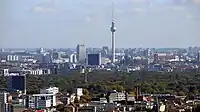 Berlin |
1 | Rhine-Ruhr | North Rhine-Westphalia | 11,199,073 | 11 | Chemnitz | Saxony | 867,051 | 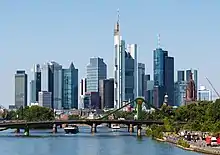 Rhine-Main 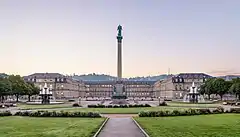 Stuttgart |
| 2 | Berlin | Berlin | 4,661,925 | 12 | Hanover | Lower Saxony | 807,181 | ||
| 3 | Rhine-Main | Hesse | 3,200,201 | 13 | Dresden | Saxony | 799,317 | ||
| 4 | Stuttgart | Baden-Württemberg | 3,044,428 | 14 | Saar | Saarland | 762,791 | ||
| 5 | Munich | Bavaria | 2,415,964 | 15 | Bremen | Bremen | 668,074 | ||
| 6 | Hamburg | Hamburg | 2,399,250 | 16 | Aachen | North Rhine-Westphalia | 663,371 | ||
| 7 | Rhine-Neckar | Baden-Württemberg | 1,426,056 | 17 | Karlsruhe | Baden-Württemberg | 612,031 | ||
| 8 | Nuremberg | Bavaria | 1,247,309 | 18 | Augsburg | Bavaria | 554,118 | ||
| 9 | Leipzig | Saxony | 1,068,429 | 19 | Freiburg im Breisgau | Baden-Württemberg | 339,767 | ||
| 10 | Bielefeld | North Rhine-Westphalia | 941,933 | 20 | Kassel | Hesse | 335,358 | ||
Netherlands
The Netherlands is the 30th-most densely populated country in the world, with 404.6 inhabitants per square kilometre (1,048/sq mi)—or 497 inhabitants per square kilometre (1,287/sq mi) if only the land area is counted. The Randstad is the country's largest conurbation located in the west of the country and contains the four largest cities: Amsterdam, Rotterdam, The Hague, and Utrecht. The Randstad has a population of 7 million inhabitants and is the 6th largest metropolitan area in Europe.
Norway
Norway defines urban areas ("tettsteder") similarly to the other Nordic countries. Unlike in Denmark and Sweden, the distance between each building has to be of less than 50 m, although exceptions are made due to parks, industrial areas, rivers, and similar. Groups of houses less than 400 m from the main body of an urban area are included in the urban area.[39]
Poland
In Poland, official "urban" population figures simply refer to those localities which have the status of towns (miasta). The "rural" population is that of all areas outside the boundaries of these towns. This distinction may give a misleading impression in some cases, since some localities with only village status may have acquired larger and denser populations than many many smaller towns[40] with most excessive example of Poznań, most spread urban area of the country with population of the city app. 534 thousand and urban area above 1,100 thousand inhabitants. On the other hand, the Upper Silesian Industrial Region conurbation with numerous large and medium cities covers 3,200 km and has approximately 3 million people. The metropolitan areas in Poland are the biggest urban zones (e.g. Upper Silesian metropolitan area, Łódź metropolitan area and Szczecin metropolitan area) and have great impact on the rural surroundings, as it is around Lublin, Radom, Kielce, Tarnów and Białystok.
Russia
Moscow, the capital and largest city of Russia, has a population estimated at 12.4 million residents within the city limits,[41] while over 17 million residents in the urban area,[42] and over 20 million residents in the Moscow Metropolitan Area.[43] It is among the world's largest cities, being the most populous city entirely within Europe, the most populous urban area in Europe,[42] the most populous metropolitan area in Europe,[43] and also the largest city by land area on the European continent.[44] Saint Petersburg, the cultural capital, is the second-largest city, with a population of roughly 5.4 million inhabitants.[45] Other major urban areas are Yekaterinburg, Novosibirsk, Kazan, Nizhny Novgorod, and Chelyabinsk.
| Rank | Name | Federal subject | Pop. | Rank | Name | Federal subject | Pop. | ||
|---|---|---|---|---|---|---|---|---|---|
 Moscow 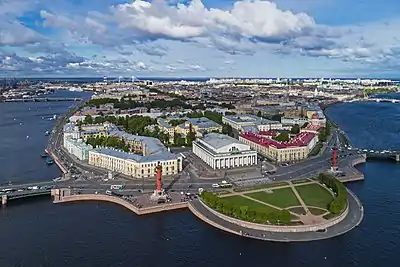 Saint Petersburg |
1 | Moscow | Moscow | 13,010,112 | 11 | Rostov-on-Don | Rostov Oblast | 1,142,162 | 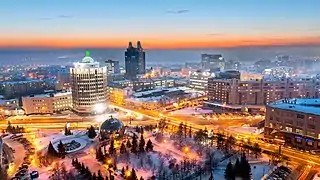 Novosibirsk 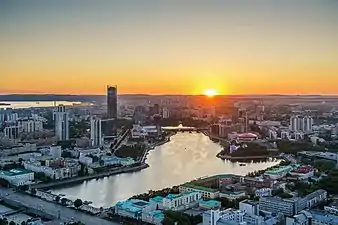 Yekaterinburg |
| 2 | Saint Petersburg | Saint Petersburg | 5,601,911 | 12 | Omsk | Omsk Oblast | 1,125,695 | ||
| 3 | Novosibirsk | Novosibirsk Oblast | 1,633,595 | 13 | Krasnodar | Krasnodar Krai | 1,099,344 | ||
| 4 | Yekaterinburg | Sverdlovsk Oblast | 1,544,376 | 14 | Voronezh | Voronezh Oblast | 1,057,681 | ||
| 5 | Kazan | Tatarstan | 1,308,660 | 15 | Perm | Perm Krai | 1,034,002 | ||
| 6 | Nizhny Novgorod | Nizhny Novgorod Oblast | 1,228,199 | 16 | Volgograd | Volgograd Oblast | 1,028,036 | ||
| 7 | Chelyabinsk | Chelyabinsk Oblast | 1,189,525 | 17 | Saratov | Saratov Oblast | 901,361 | ||
| 8 | Krasnoyarsk | Krasnoyarsk Krai | 1,187,771 | 18 | Tyumen | Tyumen Oblast | 847,488 | ||
| 9 | Samara | Samara Oblast | 1,173,299 | 19 | Tolyatti | Samara Oblast | 684,709 | ||
| 10 | Ufa | Bashkortostan | 1,144,809 | 20 | Barnaul | Altai Krai | 630,877 | ||
Spain
Spain is a very highly urbanized country. Madrid is its largest urban area. The Southern and Eastern coasts with Barcelona, Valencia and Málaga are more urbanised than the Northern and Western ones.
Sweden
Urban areas in Sweden (tätorter) are statistically defined localities, totally independent of the administrative subdivision of the country. There are 1,956 such localities in Sweden, with a population ranging from 200 to 1,372,000 inhabitants.[47]
United Kingdom
In 2013 the United Kingdom's Office for National Statistics (ONS) published 2011 Built-up Areas – Methodology and Guidance which sets out its definition of a Built-up area (BUA) as an area of built-up land of at least 20 hectares (0.077 sq mi), separated from other settlements by at least 200 metres (660 ft). For 2011 census data there are 5,493 built-up areas, of which 501 are divided into Built-up area sub-divisions (BUASD) for which data is also available. Each built-up area is named algorithmically, using Ordnance Survey place-name data.[48]
The ONS has produced census results from urban areas since 1951, since 1981 based upon the extent of irreversible urban development indicated on Ordnance Survey maps. The definition is an extent of at least 20 ha and at least 1,500 census residents. Separate areas are linked if less than 200 m (220 yd) apart. Included are transportation features.[49] The UK has five Urban Areas with a population over a million and a further sixty nine with a population over one hundred thousand.
| Rank | Urban area | Pop. | Principal settlement | Rank | Urban area | Pop. | Principal settlement | ||
|---|---|---|---|---|---|---|---|---|---|
| 1 | Greater London | 9,787,426 | London | 11 | Bristol | 617,280 | Bristol | ||
| 2 | Greater Manchester | 2,553,379 | Manchester | 12 | Edinburgh | 512,150 | Edinburgh | ||
| 3 | West Midlands | 2,440,986 | Birmingham | 13 | Leicester | 508,916 | Leicester | ||
| 4 | West Yorkshire | 1,777,934 | Leeds | 14 | Belfast | 483,418 | Belfast | ||
| 5 | Greater Glasgow | 985,290 | Glasgow | 15 | Brighton & Hove | 474,485 | Brighton | ||
| 6 | Liverpool | 864,122 | Liverpool | 16 | South East Dorset | 466,266 | Bournemouth | ||
| 7 | South Hampshire | 855,569 | Southampton | 17 | Cardiff | 390,214 | Cardiff | ||
| 8 | Tyneside | 774,891 | Newcastle upon Tyne | 18 | Teesside | 376,633 | Middlesbrough | ||
| 9 | Nottingham | 729,977 | Nottingham | 19 | Stoke-on-Trent | 372,775 | Stoke-on-Trent | ||
| 10 | Sheffield | 685,368 | Sheffield | 20 | Coventry | 359,262 | Coventry | ||
Australia
The Australian Bureau of Statistics refers to urban areas as Urban Centres, which it generally defines as population clusters of 1,000 or more people.[53] Australia is one of the most urbanised countries in the world, with more than 50% of the population residing in Australia's three biggest urban centres.[53]
| Rank | Name | State | Pop. | Rank | Name | State | Pop. | ||
|---|---|---|---|---|---|---|---|---|---|
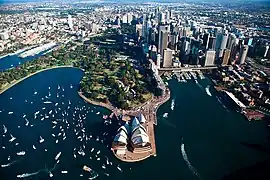 Sydney 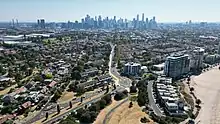 Melbourne |
1 | Sydney | NSW | 5,259,764 | 11 | Geelong | Vic | 289,400 |  Brisbane  Perth |
| 2 | Melbourne | Vic | 4,976,157 | 12 | Hobart | Tas | 251,047 | ||
| 3 | Brisbane | Qld | 2,568,927 | 13 | Townsville | Qld | 181,665 | ||
| 4 | Perth | WA | 2,192,229 | 14 | Cairns | Qld | 155,638 | ||
| 5 | Adelaide | SA | 1,402,393 | 15 | Darwin | NT | 148,801 | ||
| 6 | Gold Coast–Tweed Heads | Qld/NSW | 706,673 | 16 | Toowoomba | Qld | 143,994 | ||
| 7 | Newcastle–Maitland | NSW | 509,894 | 17 | Ballarat | Vic | 111,702 | ||
| 8 | Canberra–Queanbeyan | ACT/NSW | 482,250 | 18 | Bendigo | Vic | 102,899 | ||
| 9 | Sunshine Coast | Qld | 355,631 | 19 | Albury-Wodonga | NSW/Vic | 97,676 | ||
| 10 | Wollongong | NSW | 305,880 | 20 | Launceston | Tas | 93,332 | ||
New Zealand
Statistics New Zealand defines urban areas in New Zealand, which are independent of any administrative subdivisions and have no legal basis.[56] There are four classes of urban area: major urban areas (population 100,000+), large urban areas (population 30,000–99,999), medium urban areas (population 10,000–29,999) and small urban areas (population 1,000–9,999). As of 2021, there are 7 major urban areas, 13 large urban areas, 22 medium urban areas and 136 small urban areas. Urban areas are reclassified after each New Zealand census, so population changes between censuses does not change an urban area's classification.
Largest cities or towns in New Zealand Statistics New Zealand June 2023 estimate (SSGA18 boundaries)[57] | |||||||||
|---|---|---|---|---|---|---|---|---|---|
| Rank | Name | Region | Pop. | Rank | Name | Region | Pop. | ||
.jpeg.webp) Auckland .jpg.webp) Christchurch |
1 | Auckland | Auckland | 1,478,800 | 11 | Porirua | Wellington | 60,900 | .jpg.webp) Wellington 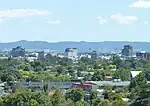 Hamilton |
| 2 | Christchurch | Canterbury | 384,800 | 12 | New Plymouth | Taranaki | 59,600 | ||
| 3 | Wellington | Wellington | 215,200 | 13 | Rotorua | Bay of Plenty | 58,900 | ||
| 4 | Hamilton | Waikato | 185,300 | 14 | Whangārei | Northland | 56,900 | ||
| 5 | Tauranga | Bay of Plenty | 161,800 | 15 | Nelson | Nelson | 51,900 | ||
| 6 | Lower Hutt | Wellington | 113,000 | 16 | Hastings | Hawke's Bay | 51,500 | ||
| 7 | Dunedin | Otago | 106,200 | 17 | Invercargill | Southland | 51,000 | ||
| 8 | Palmerston North | Manawatū-Whanganui | 82,500 | 18 | Upper Hutt | Wellington | 45,400 | ||
| 9 | Napier | Hawke's Bay | 67,500 | 19 | Whanganui | Manawatū-Whanganui | 42,800 | ||
| 10 | Hibiscus Coast | Auckland | 63,400 | 20 | Gisborne | Gisborne | 38,200 | ||
Canada
According to Statistics Canada, an urban area in Canada is an area with a population of at least 1,000 people where the density is no fewer than 400 persons per square kilometre (1,000/sq mi).[58] If two or more urban areas are within 2 km (1.2 mi) of each other by road, they are merged into a single urban area, provided they do not cross census metropolitan area or census agglomeration boundaries.[59]
In the Canada 2011 Census, Statistics Canada redesignated urban areas with the new term "population centre";[60] the new term was chosen in order to better reflect the fact that urban vs. rural is not a strict division, but rather a continuum within which several distinct settlement patterns may exist. For example, a community may fit a strictly statistical definition of an urban area, but may not be commonly thought of as "urban" because it has a smaller population, or functions socially and economically as a suburb of another urban area rather than as a self-contained urban entity, or is geographically remote from other urban communities. Accordingly, the new definition set out three distinct types of population centres: small (population 1,000 to 29,999), medium (population 30,000 to 99,999) and large (population 100,000 or greater).[60] Despite the change in terminology, however, the demographic definition of a population centre remains unchanged from that of an urban area: a population of at least 1,000 people where the density is no fewer than 400 persons per km2.
| Rank | Name | Province | Pop. | Rank | Name | Province | Pop. | ||
|---|---|---|---|---|---|---|---|---|---|
| 1 | Toronto | Ontario | 6,202,225 | 11 | London | Ontario | 543,551 | ||
| 2 | Montreal | Quebec | 4,291,732 | 12 | Halifax | Nova Scotia | 465,703 | ||
| 3 | Vancouver | British Columbia | 2,642,825 | 13 | St. Catharines–Niagara | Ontario | 433,604 | ||
| 4 | Ottawa–Gatineau | Ontario–Quebec | 1,488,307 | 14 | Windsor | Ontario | 422,630 | ||
| 5 | Calgary | Alberta | 1,481,806 | 15 | Oshawa | Ontario | 415,311 | ||
| 6 | Edmonton | Alberta | 1,418,118 | 16 | Victoria | British Columbia | 397,237 | ||
| 7 | Quebec City | Quebec | 839,311 | 17 | Saskatoon | Saskatchewan | 317,480 | ||
| 8 | Winnipeg | Manitoba | 834,678 | 18 | Regina | Saskatchewan | 249,217 | ||
| 9 | Hamilton | Ontario | 785,184 | 19 | Sherbrooke | Quebec | 227,398 | ||
| 10 | Kitchener–Cambridge–Waterloo | Ontario | 575,847 | 20 | Kelowna | British Columbia | 222,162 | ||
Mexico
Mexico is one of many countries where the urbanization rate is at least 80%. Mexico City, its capital, is the largest urban area in the country.
United States
In the United States, the Census Bureau defines urban areas and delineates urban area boundaries after each census. The Bureau defines an urban area as "a statistical geographic entity consisting of a densely settled core created from census blocks and contiguous qualifying territory that together have at least 2,000 housing units or 5,000 persons."[62] There were 2,646 urban areas identified by the Census Bureau for 2020. 511 of these had a population of 50,000 or more.[63]
For the 2000 and 2010 censuses, the Census Bureau differentiated between two kinds of urban areas: urbanized areas and urban clusters. The term urbanized area denoted an urban area of 50,000 or more people. Urban areas under 50,000 people were called urban clusters. Urbanized areas were first delineated in the United States in the 1950 census, while urban clusters were added in the 2000 census. The distinction between urbanized areas and urban clusters was removed for the 2020 census.[62]
Urban areas consist of a densely-settled urban core, plus surrounding developed areas that meet certain density criteria. Since urban areas are composed of census blocks and not cities, counties, or county-equivalents, urban area boundaries may consist of partial areas of these political units. Urban areas are distinguished from rural areas: any area not part of an urban area is considered to be rural by the Census Bureau.[62]
The largest urban area in the United States is that of New York City and its surrounding suburbs. The New York–Jersey City–Newark, NY–NJ urban area had a population of 19,426,449 as of 2020, while the larger metropolitan area had a population of 20,140,470, and the combined statistical area had a population of 23,582,649. The next five largest urban areas in the U.S. are those of Los Angeles, Chicago, Miami, Houston, and Dallas.[63] 80.0 percent of the population of the United States lives within the boundaries of an urban area as of the 2020 census.[64]
The concept of Urbanized Areas as defined by the U.S. Census Bureau is often used as a more accurate gauge of the size of a city, since in different cities and states the lines between city borders and the urbanized area of that city are often not the same. For example, the city of Greenville, South Carolina has a city population just over 68,000 and an urbanized area population of around 400,000, while Greensboro, North Carolina has a city population just over 285,000 and an urbanized area population of around 300,000 — meaning that Greenville is actually "larger" for some intents and purposes, but not for others, such as taxation, local elections, etc.
In the U.S. Department of Agriculture's natural resources inventory, urban areas are officially known as developed areas or urban and built-up areas. Such areas include cities, ethnic villages, other built-up areas of more than 10 ac (4 ha), industrial sites, railroad yards, cemeteries, airports, golf courses, shooting ranges, institutional and public administration sites, and similar areas. The 1997 national resources inventory placed over 98,000,000 ac (40,000,000 ha) in this category, an increase of 25,000,000 ac (10,000,000 ha) since 1982.[65]
Argentina
Argentina is highly urbanized.[66] The ten largest metropolitan areas account for half of the population, and fewer than one in ten live in rural areas. About 3 million people live in Buenos Aires City and the Greater Buenos Aires metropolitan area totals around 15 million, making it one of the largest urban areas in the world, with a population of 18 million all up.[67]
Córdoba has around 1.5 million people living in the urban area, while Rosario, Mendoza and Tucumán have around 1.2 million inhabitants each[67] and La Plata, Mar del Plata, Salta and Santa Fe[67][68] have at least 500,000 people each.
Brazil
Largest urban agglomerations in Brazil | |||||||||
|---|---|---|---|---|---|---|---|---|---|
| Rank | Name | State | Pop. | Rank | Name | State | Pop. | ||
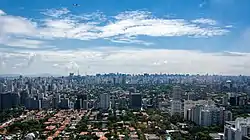 São Paulo 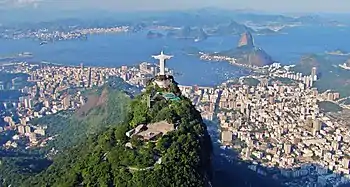 Rio de Janeiro |
1 | São Paulo | São Paulo | 21,314,716 | 11 | Belém | Pará | 2,157,180 |  Belo Horizonte 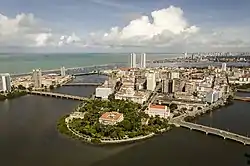 Recife |
| 2 | Rio de Janeiro | Rio de Janeiro | 12,389,775 | 12 | Manaus | Amazonas | 2,130,264 | ||
| 3 | Belo Horizonte | Minas Gerais | 5,142,260 | 13 | Campinas | São Paulo | 2,105,600 | ||
| 4 | Recife | Pernambuco | 4,021,641 | 14 | Vitória | Espírito Santo | 1,837,047 | ||
| 5 | Brasília | Federal District | 3,986,425 | 15 | Baixada Santista | São Paulo | 1,702,343 | ||
| 6 | Porto Alegre | Rio Grande do Sul | 3,894,232 | 16 | São José dos Campos | São Paulo | 1,572,943 | ||
| 7 | Salvador | Bahia | 3,863,154 | 17 | São Luís | Maranhão | 1,421,569 | ||
| 8 | Fortaleza | Ceará | 3,594,924 | 18 | Natal | Rio Grande do Norte | 1,349,743 | ||
| 9 | Curitiba | Paraná | 3,387,985 | 19 | Maceió | Alagoas | 1,231,965 | ||
| 10 | Goiânia | Goiás | 2,347,557 | 20 | João Pessoa | Paraíba | 1,168,941 | ||
See also
References
- "Federal Register/Vol. 75, No. 123/Monday, June 28, 2010/Notices" (PDF). US Census Bureau. Retrieved July 22, 2023.
-
Morris, A.E.J. (2 December 2013) [1972]. "The Early Cities". History of Urban Form Before the Industrial Revolution (3 ed.). London: Routledge. p. 1. ISBN 9781317885146.
[...] the Bronze Age, starting between 3500 and 3000 BC [...]. During this [...] period the first urban civilizations were firmly established.
- "City population to reach 6.4bn by 2050". Herald Globe. Archived from the original on 2014-07-14. Retrieved 11 July 2014.
- "United Nations Population Division – Department of Economic and Social Affairs".
- "Urban population growth". World Health Organization. Archived from the original on March 8, 2012.
- "Current world population". United Nations, Department of Economic and Social Affairs. Archived from the original on 2 July 2014. Retrieved 11 July 2014.
- "Climate Change 2022: Mitigation of Climate Change". www.ipcc.ch. Retrieved 2022-04-04.
- "Urban land area (km²)". Our World in Data. Retrieved 6 March 2020.
- "2011 Census: Characteristics of Built-Up Areas (4. Introduction)". Office for National Statistics. 28 June 2013. Retrieved 20 October 2019.
- "World Factbook Urbanization". Central Intelligence Agency. Retrieved 26 August 2018.
- "CIA The World Factbook – Major urban areas: population".
- Dijkstra, Lewis; Poelman, Hugo (2014). "A harmonised definition of cities and rural areas: the new degree of urbanisation" (PDF). Regional Working Paper. Europa Commission. Retrieved 16 August 2021.
- "Preparing for China's urban billion". McKinsey Global Institute. February 2009. Archived from the original on 24 December 2012. Retrieved 12 December 2012.
- "China urbanization (PDF)" (PDF). World Bank Institute. 2011. Archived from the original (PDF) on 15 January 2013. Retrieved 12 December 2012.
- Harney, Alexandra (3 February 2008). "Migrants are China's 'factories without smoke'". CNN. Retrieved 27 March 2009.
- Tschang, Chi-Chu (4 February 2009). "A Tough New Year for China's Migrant Workers". Business Week. Archived from the original on February 8, 2009. Retrieved 27 March 2009.
- Francesco Sisci. "China's floating population a headache for census". The Straits Times. 22 September 2000.
- Ministry of Housing and Urban-Rural Development of the People's Republic of China(MOHURD) (2021). 中国城市建设统计年鉴2020 [China Urban Construction Statistical Yearbook 2018] (in Chinese). Beijing: China Statistic Publishing House.
- August 2018 (PDF). Hong Kong Monthly Digest of Statistics (Report). Census and Statistics Department. August 2018. p. 4.
- Chongqing Statistics Bureau (2019). 重庆统计年鉴2019 [Chongqing Statistical Yearbook 2019] (in Chinese). Beijing: China Statistic Publishing House. p. 613. ISBN 978-7-5037-8854-3.
- "Provisional Population Totals Urban Agglomerations and Cities, Data Highlights" (PDF). Census of India 2011. 13 February 2012.
- "Urban Agglomeration". Arthapedia. India Economic Service. 10 April 2015.
- "Table 3: Urban agglomerations having population 1 Lakh and above" (PDF). Provisional Population Totals. Government of India. Retrieved 2011-10-19.
- "Agglomerations & Cities". INDIA: States and Major Agglomerations Population Totals. Office of the Registrar General and Census Commissioner. Retrieved 2020-03-27.
- "The Urban Frontier—Karachi". NPR. National Public Radio. 2 June 2008. Retrieved 2 July 2008.
- Jason Burke (17 August 2008). "Pakistan looks to life without the general". The Guardian. London. Retrieved 20 May 2010.
- "Bangladesh Population & Housing Census-2011" (PDF). Bangladesh Bureau of Statistics. March 2014. Archived (PDF) from the original on 8 December 2015.
- Population and Housing Census 2011 – Volume 3: Urban Area Report (PDF), Bangladesh Bureau of Statistics, Aug 2014
- "World: metropolitan areas". World Gazetteer. Archived from the original on 2007-09-30. Retrieved 2010-01-22.
- "The State of Asian and Pacific Cities 2015" (PDF). United Nations ESCAP. 2015. Retrieved August 18, 2021.
- "Singapore Urban Redevelopment Authority". URA (Singapore). Retrieved August 18, 2021.
- "Urban Redevelopment Authourity". Archived from the original on 2007-06-12. Retrieved 2007-06-02.
- "Locality – Concepts". Statistics Finland.
- "Alueluokkien kuvaukset". Ymparisto.
- "Urban unit". Definitions, methods and quality. INSEE. October 31, 2016. Retrieved 2019-01-18.
- "Urban area". Definitions, methods and quality. INSEE. October 31, 2016. Retrieved 2019-01-18.
- "Tableaux de l'économie française, Édition 2020, Villes et communes de France". INSEE. Retrieved 11 December 2020.
- "Verdichtungsräume nach Fläche, Bevölkerung und Bevölkerungsdichte am 31.12.2017, im November 2018 wegen korrigierter Bevölkerung revidiert" (in German). Statistisches Bundesamt. 2017. p. 10. Retrieved 24 March 2019.
- "Population statistics. Population and land area in urban settlements, 1 January 2008". Statistics Norway. June 20, 2008. Retrieved 2009-04-17.
- "Polish official population figures".
- "RUSSIA: Central'nyj Federal'nyj Okrug – Central Federal District". City Population.de. August 8, 2020. Retrieved September 1, 2020.
- "Demographia World Urban Areas" (PDF). Demographia. Retrieved July 22, 2020.
- Alexander Akishin (August 17, 2017). "A 3-Hour Commute: A Close Look At Moscow The Megapolis". Strelka Mag. Retrieved May 23, 2020.
- "Moscow, a City Undergoing Transformation". Planète Énergies. September 11, 2017. Retrieved May 27, 2020.
- "RUSSIA: Severo-Zapadnyj Federal'nyj Okrug: Northwestern Federal District". City Population.de. 8 August 2020. Retrieved October 24, 2020.
- "Оценка численности постоянного населения по субъектам Российской Федерации". Federal State Statistics Service. Retrieved 1 September 2022.
- "Fortsatt stor ökning av befolkning i tätorter". Statistics Sweden. Archived from the original on 2012-01-12. Retrieved 2011-06-24.
- ONS Geography (August 2015). "2011 Built-up Areas – Methodology and Guidance". Office for National Statistics.
- KS01 Usual resident population: Census 2001, Key Statistics for urban areas
For the OS definition of an Urban Area, see the notes tab on the Excel version. - "2011 Census - Built-up areas". ONS. Retrieved 1 July 2013.
- "NRS – Background Information Settlements and Localities" (PDF). National Records of Scotland. Retrieved 29 September 2020.
- The UK's major urban areas Office for National Statistics (Urban area of Belfast and connected settlements, Table 3.1, page 47)
- "Australian Statistical Geography Standard (ASGS)". 23 May 2011. Retrieved 21 October 2021.
- "3218.0 – Regional Population Growth, Australia, 2019–20". Australian Bureau of Statistics. 30 March 2021. Archived from the original on 30 March 2021. Retrieved 30 March 2021.
- "Regional Population, 2021". Australian Bureau of Statistics. 20 April 2023.
- "Urban area: Definition". Statistics New Zealand. Archived from the original on 13 November 2013. Retrieved 10 December 2014.
- "Subnational population estimates (RC, SA2), by age and sex, at 30 June 1996-2023 (2023 boundaries)". Statistics New Zealand. Retrieved 25 October 2023. (regional councils); "Subnational population estimates (TA, SA2), by age and sex, at 30 June 1996-2023 (2023 boundaries)". Statistics New Zealand. Retrieved 25 October 2023. (territorial authorities); "Subnational population estimates (urban rural), by age and sex, at 30 June 1996-2023 (2023 boundaries)". Statistics New Zealand. Retrieved 25 October 2023. (urban areas)
- "Urban area (UA)". Statistics Canada. 2009-11-20. Retrieved 2011-01-21.
- "More information on Urban area (UA)". Statistics Canada. 2009-11-20. Retrieved 2011-01-21.
- "From urban areas to population centres" Archived 2012-12-13 at the Wayback Machine. Statistics Canada, May 5, 2011.
- "Census metropolitan area (CMA) and census agglomeration (CA)". Illustrated Glossary. November 15, 2017. Retrieved September 8, 2023.
- United States Census Bureau (March 24, 2022). "Urban Area Criteria for the 2020 Census-Final Criteria". Federal Register.
- "List of 2020 Census Urban Areas". United States Census Bureau. Retrieved December 30, 2022.
- "Nation's Urban and Rural Populations Shift Following 2020 Census". census.gov. United States Census Bureau. December 29, 2022.
-
 This article incorporates public domain material from Jasper Womach. Report for Congress: Agriculture: A Glossary of Terms, Programs, and Laws, 2005 Edition (PDF). Congressional Research Service.
This article incorporates public domain material from Jasper Womach. Report for Congress: Agriculture: A Glossary of Terms, Programs, and Laws, 2005 Edition (PDF). Congressional Research Service. - "Field listing – Urbanization". The World Factbook. CIA. Archived from the original on July 25, 2009.
- "Major Cities". Government of Argentina. Archived from the original on 19 September 2009.
- "Ubicación de la ciudad de salta" (in Spanish). Directorate-General of Tourism, Municipality of the City of Salta. Archived from the original on 2010-01-17.
- "Metropolitan Areas, Urban Agglomerations and Integrated Development Areas | IBGE". www.ibge.gov.br. Archived from the original on 2021-04-02. Retrieved 2021-04-02.
- "Mais da metade da população vive em 294 arranjos formados por contiguidade urbana e por deslocamentos para trabalho e estudo" (in Portuguese). Brazilian Institute of Geography and Statistics. Retrieved 16 March 2017.
- "Arranjos Populacionais e Concentrações Urbanas do Brasil" (PDF) (in Portuguese). Brazilian Institute of Geography and Statistics. p. 148. Retrieved 16 March 2017.
- "Estimativas da população residente no Brasil e Unidades da Federação com data de referência em 1º de julho de 2017" (PDF) (in Portuguese). Brazilian Institute of Geography and Statistics. Retrieved 14 May 2018.
External links
- United Nations Statistics Division (UNSTAT): Definition of "urban"
- World Urban Areas All identified world urbanized areas 500,000+ and others: Population & Density.
- Geopolis: research group, University of Paris-Diderot, France for world urban areas
- Gridded Population of the World – contains links to urban area definitions and maps for over 230 countries/territories
- City Mayors – The World's Largest Urban Areas in 2006
- City Mayors – The World's Largest Urban Areas Projected for 2020
- PopulationData – World's largest urban areas 1,000,000+ population
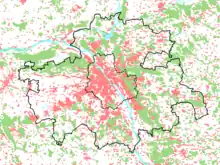

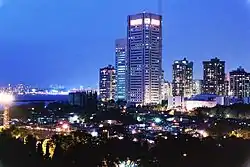
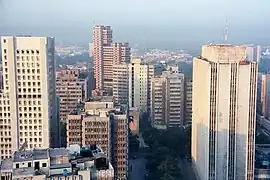
_2013-06-30_22-44.jpg.webp)
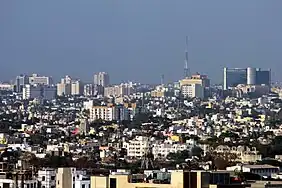


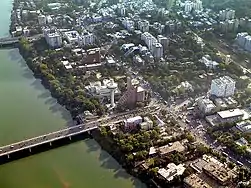

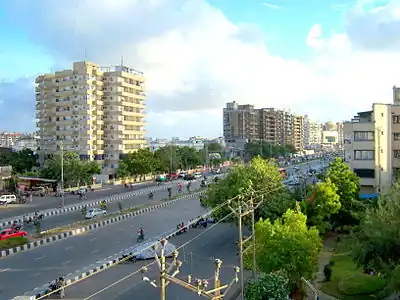
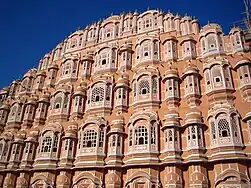
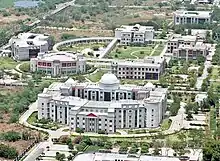
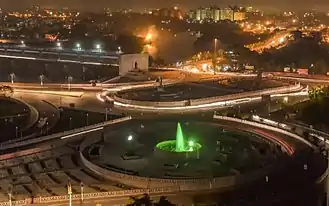




.jpg.webp)